Apium graveolens
I’ll admit it: as a kid, walking past the soldierly rows of celery in my mom’s garden made me shudder.
Celery was the stringy offender in the otherwise pleasant garden vegetable soup she offered up on summer nights.
But then one day, my friend’s mom served celery sticks slathered with sugary peanut butter as our playdate snack. I was hooked!

We link to vendors to help you find relevant products. If you buy from one of our links, we may earn a commission.
Now, I plan to plant celery in my next summer garden here in Alaska. Garden celery tastes much better than the store-bought stuff, and it’s time to properly introduce my three-year-old son to one of my favorite childhood snacks.
Celery leaves, used as herbs, also make a tasty addition to soups.
While celery has a reputation as a fickle plant to grow, it’s pretty easy once you understand exactly what it needs in order to thrive.
What You’ll Learn
What Is Celery?
Celery is considered both a vegetable and an herb belonging to the genus Apium and the family Apiaceae, which also includes coriander, celeriac, parsley, fennel, and carrots.
Native to certain regions in Africa, Asia, and Europe, Apium plants flourish in marshy growing conditions. Most of us don’t have swamps for backyards, so it’s a good thing celery’s been cultivated for easily achievable garden conditions.
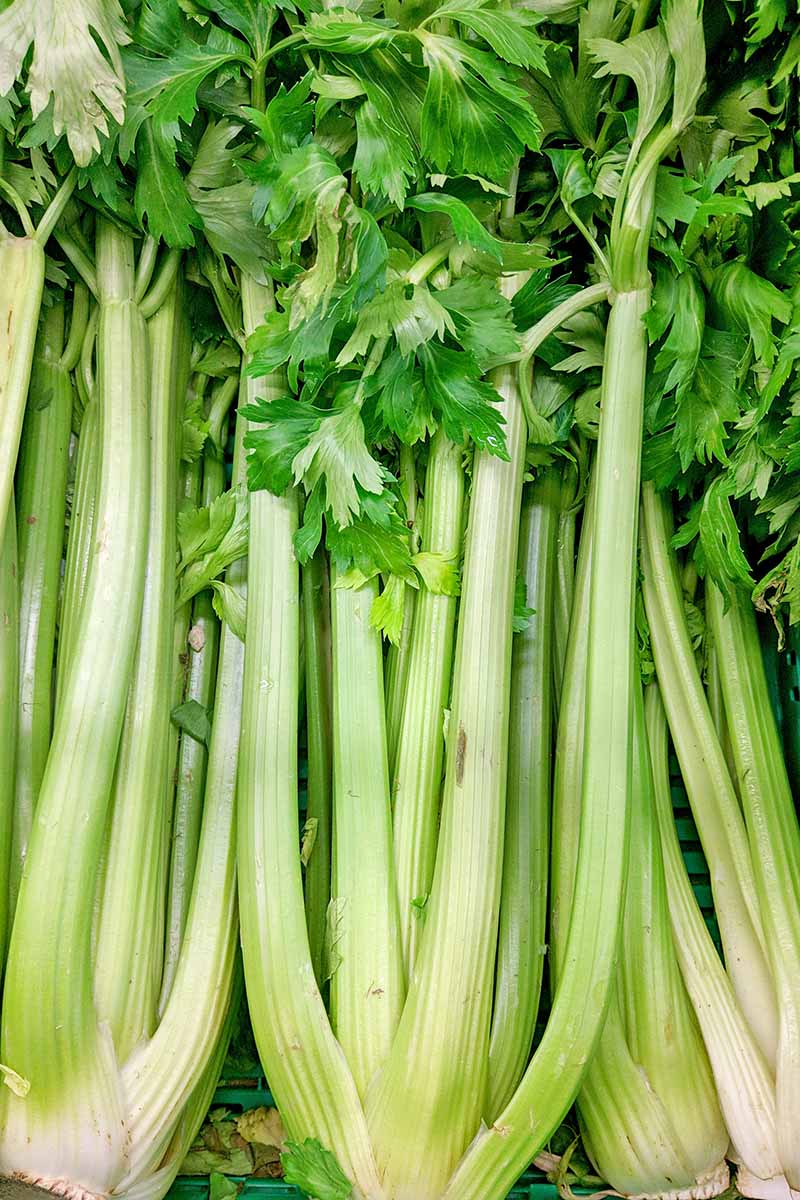
In addition to having a crisp, tasty crunch, celery is high in vitamin K, vitamin A, folate, and potassium.
Celery is even the star of a recent celebrity-fueled detox drink: pure celery juice. While the juice may not provide the magical healing properties its adorers claim, it is a nutritious drink.
You can reap the same benefits by including celery in the regular meals you make.
Cultivation and History
Celery makes a surprise appearance in Homer’s “Odyssey,” referenced as selinon, the Latin form of the Greek word for the plant.
Celery probably originated in the Mediterranean, but by the 1600s, it was a staple flavoring throughout Europe, known in France as celeri. Gardeners in 18th-century France, England, and Germany are credited with mitigating celery’s strong flavor to make it more palatable as an everyday vegetable.
We don’t know who brought celery to the Americas, but by 1806, four cultivated varieties of celery were recorded in North America.
Celery forms one-third of the Holy Trinity of Cajun and Creole cooking, which also includes green bell peppers and onions.
Together, these three vegetables become the base for gumbo, jambalaya, and a whole host of tasty Louisiana dishes. You can read more about this topic on our sister site, Foodal.
Celery Plant Propagation
You can start celery from seed indoors or outdoors, from seedlings bought at a greenhouse, or even from a used stalk of grocery store celery.
In the high North – like Alaska – celery should be a summer crop. In hot, humid areas like the American South, it makes a perfect winter crop. Elsewhere, it’s an ideal fall crop.
From Seed
If you live in a colder climate, you’ll want to start your seeds indoors about eight to 10 weeks before the last frost. This typically translates into early to mid-March.
Celery needs about three to four months to grow, so if you want a fall crop, sow in May or June. For a winter crop, sow seeds in September or October.
Lots of beginner gardeners get frustrated with celery because it doesn’t seem to ever sprout. The thing is, celery seeds aren’t planted like other seeds – not if you want them to grow, at least.
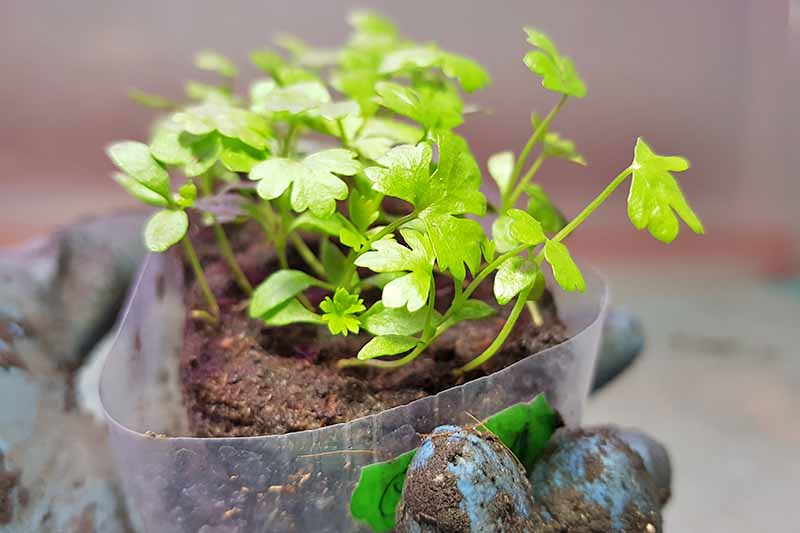
Make sure you start with a loose bed of soil in each cell. Tamp it down with your finger and add two or three seeds to each cell, but do not push the seeds down. They should be laid bare for the sunshine to see!
I know it might feel difficult to see them so vulnerable, but celery seeds need direct sunlight in order to germinate. If you don’t have lots of sunny windows, invest in a fluorescent grow light to give your seeds the light they need.
Keep the lights close to the soil and follow all the manufacturer’s instructions carefully for best results.
Another important tip is to avoid planting the seeds in clumps of four or more. Celery seeds are notoriously tiny, so this isn’t always easy. But if you plant too many near each other, you’ll find yourself doing a lot of thinning later on.
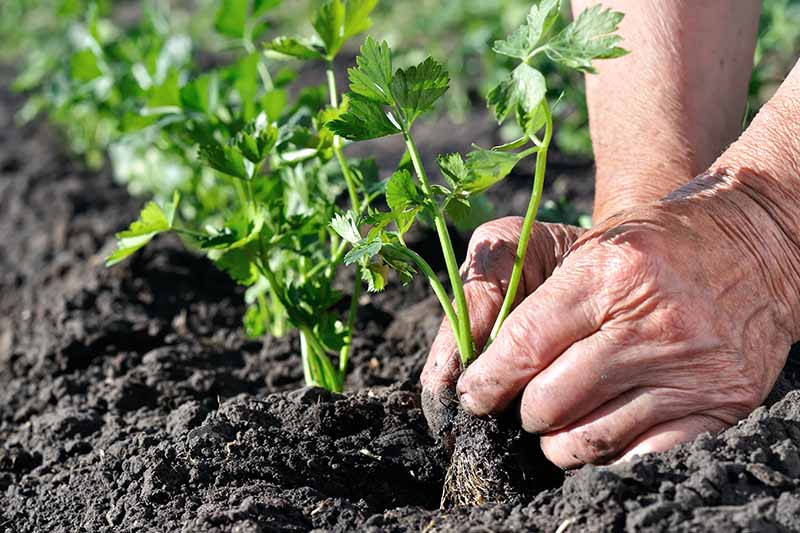
One trick is to dip a cotton swab in water and then touch the seeds with it. Scrape seeds off and onto the planting soil one by one with a toothpick. If you have excellent fine motor skills, of course, you can just use your fingers like tweezers.
Set your seed tray near a sunny window and keep a spray bottle handy. Your delicate seeds will need to stay damp. You can cover the seed tray with some plastic wrap to keep it nice and humid in there, too.
Once you see the first plants start poking through the earth, remove the plastic wrap.
And don’t fret if your celery takes its sweet time to sprout. Germination can take up to 18 days! Before you transplant your seedlings outdoors, harden them off for seven to 10 days.
If you live in a warmer climate and are planning a winter crop, sow your seeds directly into your outdoor garden in late summer or early fall. Plant seeds about a foot apart, and make sure the soil is loose and compost-rich.
From Grocery Store Celery Stalks
Did you recently buy a stalk of celery from the grocery store? Don’t throw it away! Instead, cut off the base. Set it in a bowl of water to soak, keeping it near a window. The cut stalks should face upward.
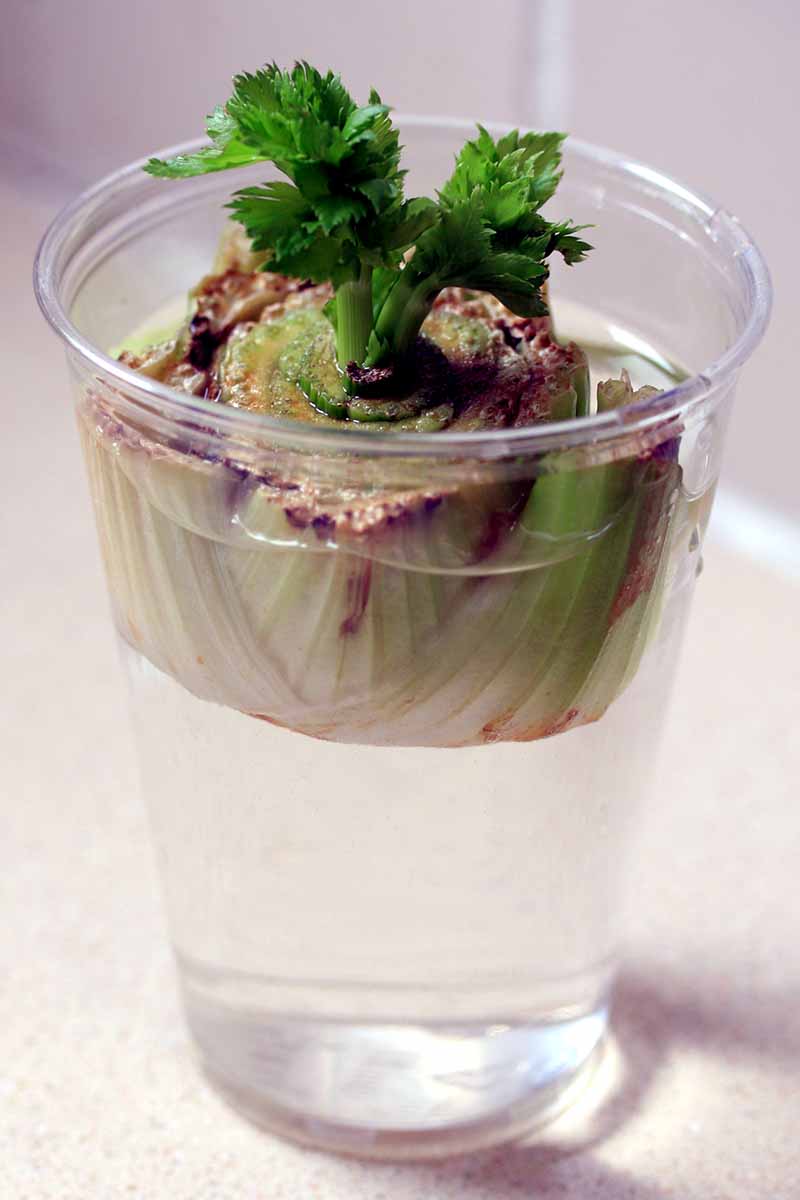
After a week has passed, you’ll notice tiny green leaves growing in the center of the base. Transfer it to a pot or your vegetable garden and cover everything but the little leaves with the same loose, moist soil you’d use for planting celery seeds.
Keep the celery plant watered and watch as new stalks grow from the old base. It’s really kind of a beautiful life cycle to witness. Plus, your store bought celery is basically giving you a bonus plant.
From Seedlings/Transplanting
If you’ve picked up celery starts from a nursery or your seedlings are ready to transfer outdoors, first make sure the soil will provide a premium home for your wee celery plants.

Celery needs five to seven hours of full sun every single day, so make sure you pick somewhere bright. Next, prepare the soil. Celery roots are fragile and hairlike, so they won’t grow well in clay or sand, or plain old heavy dirt.
Fill a raised bed with super rich soil – think a nearly pure-compost environment. Gently rake an all-purpose fertilizer through the top layer of soil and add some used coffee grounds to the mix, too.
Why add coffee?
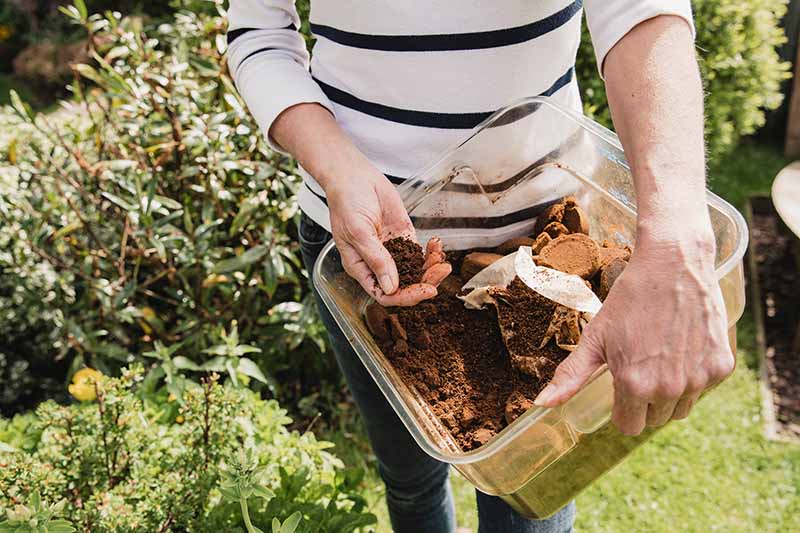
Because the nitrogen in the pH-neutral used coffee grounds will help your celery plants thrive. (In that way, I am much like a celery plant.)
Finally, test the soil’s pH levels. Celery doesn’t like too much acidity or alkalinity, so you’re looking for a neutral number between 6.5 and 7.5.
When you’re ready to transplant, make sure there’s only one celery plant per bulb. If there’s more than one, remove it and toss it into your evening salad. Space each plant about 12 inches apart and keep evenly moist.
How to Grow Celery
Celery is generally a cold-hardy plant, and it suffers in too much heat.
But don’t transplant too early. You want the soil to warm up to about 50°F with outdoor temperatures remaining above 40°F throughout the night. Plant too soon and your celery might bolt.
In addition, the soil should be:
- Loose
- Very rich in compost (either store bought or home-brewed), used coffee grounds, and planting soil
- Kept evenly watered but not boggy, despite celery’s marshy beginnings
- Free of weeds
Celery needs about 130 to 140 days to mature between seeding and harvest. But celery care doesn’t stop once you’ve transplanted your seedlings.

Greenhouse-grown varieties and some seed cultivars need blanching in order to keep from becoming too bitter.
To blanch your celery plants, wait until they double in size from their seedling height. Then, bank soil up around the plant’s base.
This will keep sunlight from reaching the bottom half of the stalks, producing a white, less bitter, and slightly less nutrient-dense stalk.
You can also purchase self-blanching cultivars if you want to avoid this step. You’ll probably still want to tie the heads of the celery stalks together to support blanching.
For more information on appropriate blanching, read our full guide. Or, if you prefer full-blooded, bitter celery, don’t blanch it at all.
Keep your celery fertilized in its second, third, and fourth months by adding a tablespoon of 5-10-10 fertilizer to a tamped-down area dug about three inches away from the plant.
Above all, keep that celery watered! It needs between one and one and a half inches of water per week. If celery doesn’t get the moisture it needs, it’ll shrivel and get extra stringy. My childhood self shudders at the very idea.
Growing Tips
- Keep the soil rich in organic nutrients.
- Make sure your celery gets all the sunlight it needs.
- Fertilize in the second, third, and fourth months.
- Water evenly and regularly if Mother Nature doesn’t do it for you.
Ignoring any of these requirements may result in thin and underdeveloped plants.
Celery Cultivars to Select
Here are the most popular celery varieties for your home garden:
Pascal
The most common stalk celery cultivar grown in the United States, ‘Pascal’ thrives in USDA Hardiness Zones 2 to 10.
Find seeds for ‘Pascal’ celery at Eden Brothers.
Stalks will grow about 12 inches tall, and will be ready to hop into your evening stew after about 130 days.
Tall Utah
This popular variety grows to crisp, stringless one-foot stalks. It’s perfect for snacking on right out of the garden (with peanut butter, of course) and grows best in Zones 4 to 10.
You can buy packets, 1-ounce packages, and even 1-pound sacks if celery is your favorite food in the universe at Eden Brothers.
Tango
This sweet, extra-crunchy hybrid variety grows extra tall: up to 18 inches! You can also sow these six to eight inches apart instead of 12, which makes for a heartier crop.
This variety matures faster than older celery varieties, too – enjoy it just 85 days after planting. Plus, it’s hardier to temperature fluctuations, making it a nice choice for beginners.
‘Tango’ is resistant to fusarium wilt. You can find seeds in a variety of packet sizes at High Mowing Seeds.
Chinese or Cutting Celery
If you prefer celery with a stronger flavor and hollow stalks, this is the variety for you.
Chinese celery grows well in cooler climates, thriving in Zones 2-10. It grows up to 12 inches tall and matures in 100 days. You can find it at True Leaf Market.
Want More Options?
Be sure to check out our “9 of the Best Celery Cultivars for Your Garden” to find the best match for your climate and soil type.
Managing Pests and Disease
While celery’s pretty good at fending off creepy-crawly predators, it does occasionally fall prey to pests, diseases, and fungus.
Insects
There are a number of insect pests that can have a tasty meal from your celery crop.
Aphids
Aphids just can’t get enough of… every living green thing in the universe. There aren’t enough ladybugs in the world to keep track of all the aphids. But, you can try.
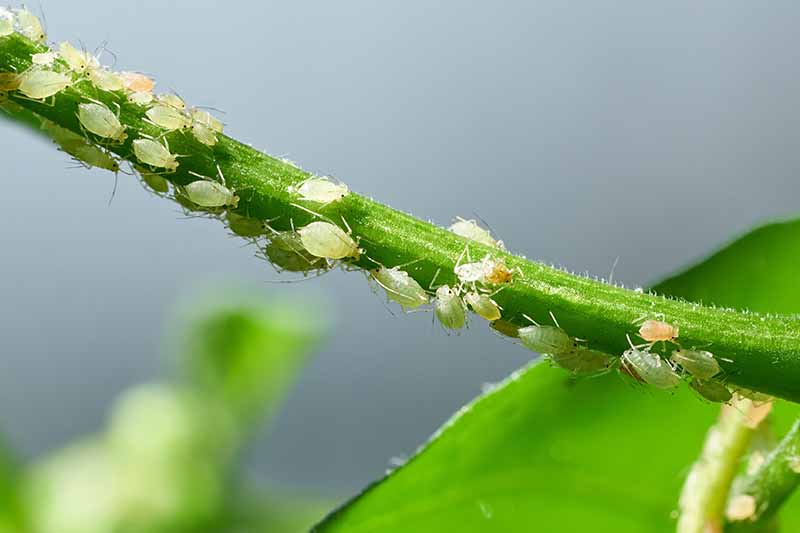
If you see ladybugs around your yard, carefully transport them to your aphid-riddled celery. Their bellies will thank you.
In addition to sucking all the life out of your celery, aphids contribute to the growth and spread of celery mosaic virus. You can read this article for more tips on how to combat aphids.
Thrips
They might have a cute name, but thrips are anything but. Thrips are tiny winged bugs that slurp up all your celery’s fluid, which is terrible because celery has a lot of water in it.

Check your celery leaves for black dots of thrip poop, or frass. To control a thrips infestation, use neem oil or insecticidal soap on your plants.
Read more about thrip identification and control here.
Celery Leaftier
This moth is only about three quarters of an inch in size, but it’ll chew holes all over your celery plants and string little webs in between the leaves.
If you catch sight of leaftiers in their caterpillar phase or even later, don’t mourn the loss of your precious plants. A couple doses of pyrethrum dust should get rid of the bugs.
European Corn Borer
The European corn borer looks a lot like the celery leaftier, but it attacks your celery stems. Not good!

Try using Bacillus thuringiensis (Bt) to control the larvae of these pests before they do serious damage.
Diseases
There are a few diseases you’ll want to watch out for.
Bacterial Blight and Brown Stem
If your celery stalks start turning brown in places and the leaf blades develop circular spots of rot, your plant might be suffering from bacterial blight, Pseudomonas cichorii.
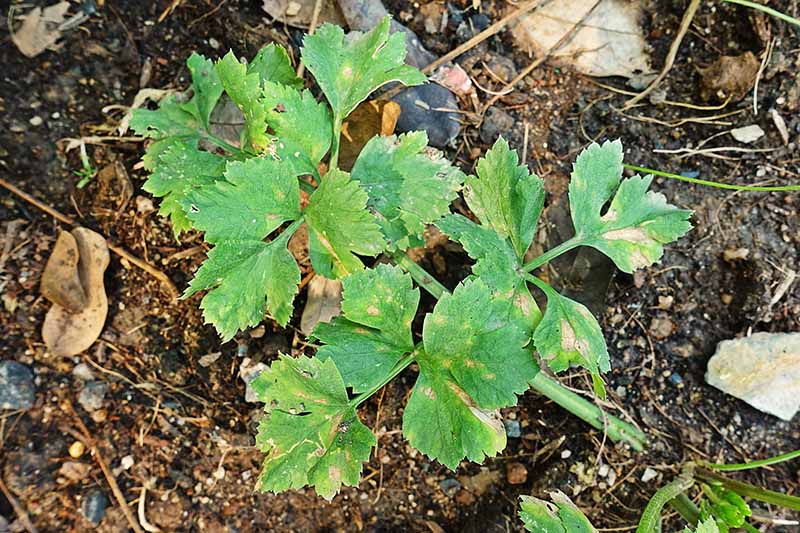
One way to prevent this is to ensure a spread of at least 12 inches between plants so that the leaves can’t spread the infection.
Soft Rot
Caused by three different types of bacteria – Erwinia carotovora, E. chrysanthemi, and P. marginalis, soft rot attacks the base of your plant and turns it slimy and mushy.
Always use fresh, clean water to hydrate your plants and allow time for the soil to dry between waterings. At first signs of rot, remove the affected stalks. If the entire base of your plant is brown and mushy, however, you may need to pull the whole plant.
Celery Mosaic Virus
Spread by aphids, this virus stunts plants, causes dark splotches to appear on stalks, and curls leaves.
The best way to avoid celery mosaic virus is to keep aphids managed. Pull affected plants immediately to stop the virus from spreading.
Downy Mildew
Downy mildew (Peronospora umbellifarum), is easy to spot due to the fluffy, moldy growths that’ll appear on the underbellies of your poor celery leaves. You might also notice yellow spots on the leaves.
Treat with fungicide from your local garden center.
Fusarium Yellows
Fusarium yellows (Fusarium oxysporum) is a fungus that turns your plants soft and brown at the base and yellow everywhere else. Some celery cultivars, like the ‘Tango Hybrid,’ are fusarium-resistant.
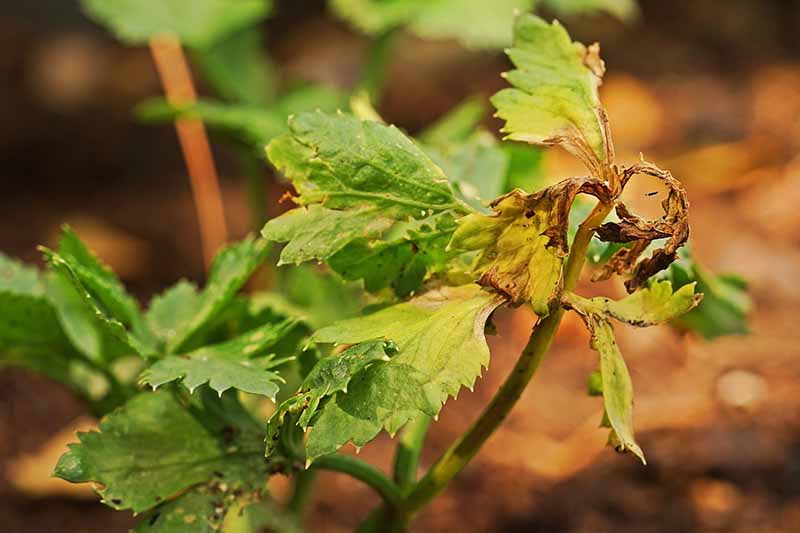
Keep your gardening tools clean between uses to help avoid fungus development and spread.
Harvesting Celery
Depending on the variety, you can harvest celery 85 to 110 or so days after transplanting. Once the stalks are at least six inches tall from the bottom of the stalk to the first leaf, they’re ready to eat.
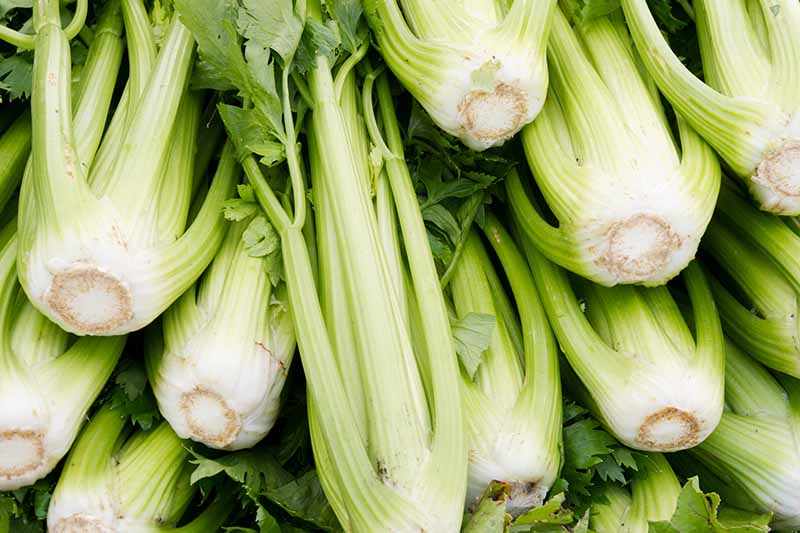
If you don’t need all your celery at once, cut off individual stalks from the outside in. Outer stalks tend to be greener and stronger in flavor (especially if they haven’t been blanched) whereas inner stalks, with the natural blanching provided by the outer stalks, are lighter and sweeter.
You can also harvest the entire plant at once.
Read more about celery harvesting here.
Preserving
To keep celery fresh in your refrigerator for up to two weeks, remove the leaves, wrap stalks in moist towels, and seal in plastic bags. Keep them in the crisper section of your refrigerator and don’t forget they’re there! Use those celery leaves within the first couple of days to ensure the best flavor.
If you want to keep celery in your freezer for the winter months, you can:
- Cut it to cooking size.
- Blanch it in boiling water for one minute.
- Drop it into some ice water.
- Remove and allow to dry.
- Stick in a freezer bag and pop into the freezer. Voila!
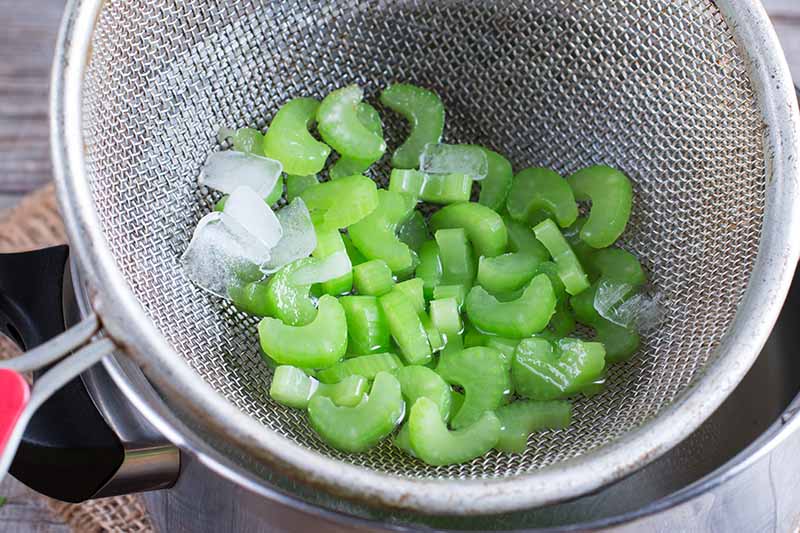
Use within 12 to 18 months, and remember: it won’t have that signature crunch once you take it out of the freezer, making it less ideal for snacking but fantastic for cooking.
Recipes and Cooking Ideas
Celery leaves can add pep to a salad or pasta. The stalks make perfect afternoon snacks for your kids, and you can also try your hand at making gumbo or jambalaya with your fragrant garden celery.
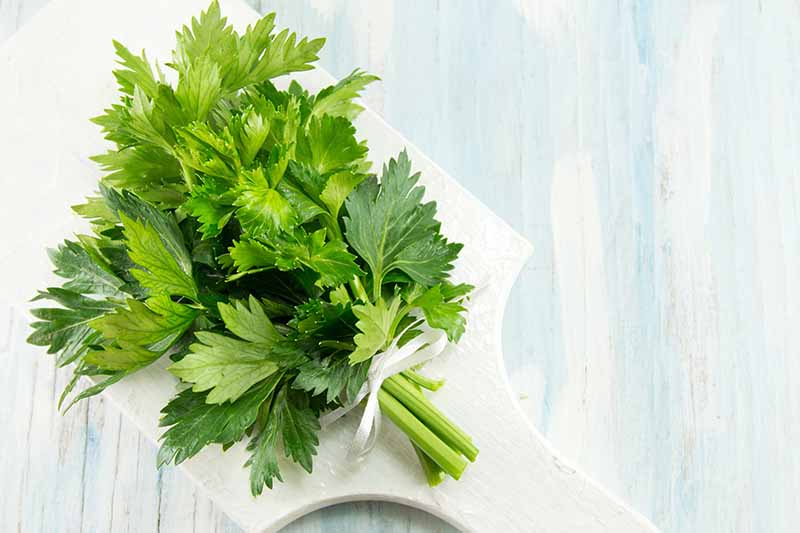
On our sister site, Foodal, celery’s one of the star ingredients in an easy homemade seafood stock recipe. A winning vegetable stock recipe to suit all your cooking needs throughout the year is available on Foodal as well.
Quick Reference Growing Guide
| Plant Type: | Biennial, annual | Water Needs: | 1-1.5 inches per week |
| Native to: | Mediterranean | Maintenance: | Medium |
| Hardiness (USDA Zone): | 4-10, some varieties hardy to 2 or 3 | Soil Type: | Loose and rich |
| Season: | Spring, fall, early winter | Soil pH: | 6.5-7.5 |
| Exposure: | Full sun | Soil Drainage: | Well-draining |
| Time to Maturity: | 120-130 days | Companion Planting: | Daisies, tomatoes, leeks |
| Spacing: | 12 inches | Avoid Planting With: | Asters, carrots, corn |
| Planting Depth: | Very shallow (don’t bury) | Order: | Apiales |
| Height: | 12-18 inches | Family: | Apiaceae |
| Spread: | 4-6 inches | Genus: | Apium |
| Tolerance: | Light frost | Species: | graveolens |
| Common Pests: | Aphids, celery leaftier, European corn borer, thrips | Common Disease: | Bacterial blight, celery mosaic virus, downy mildew, fusarium yellows, soft rot |
So Much More Than a Stringy Nuisance
Even if you think you hate celery, like I did as a kid, try growing it in your garden. You might be surprised at how crisp, flavorful, and devoid of strings it is!
Just make sure you sow your celery plants in loose, rich soil and provide them with plenty of sunshine and water.

Harvest a few stalks at a time or entire plants at once. Savor fresh stalks as an afternoon snack or a perfect addition to your favorite stew. And remember to use a bunch of celery to make vegetable stock!
Have you tried growing celery yet? Did it flop or flourish? Share your woes and triumphs in the comments below!
If you’d like to grow other celery-like plants, check out these articles:


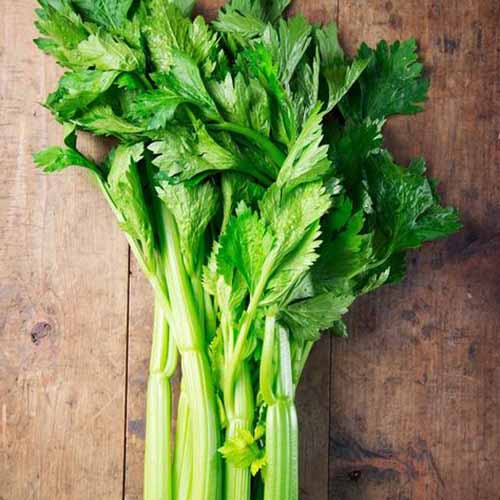
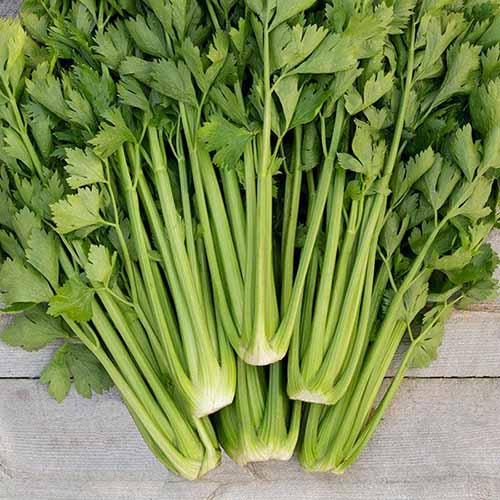
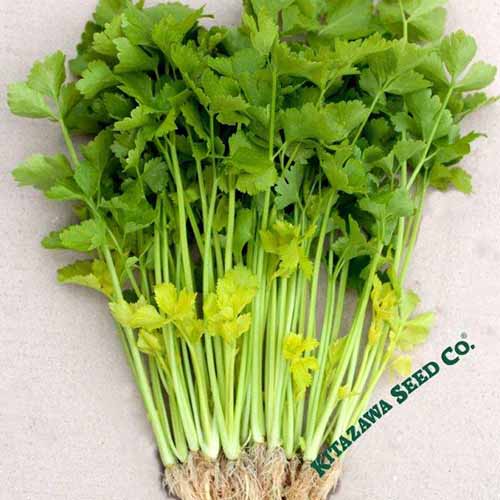
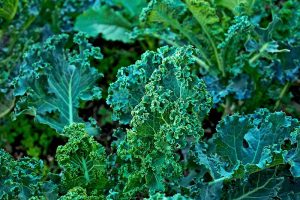
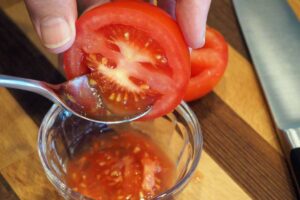

Hello Claire, regrowing the celery looks like a great idea.
Thank you
Richard
It’s definitely a fun project to try with kids. Thank you for visiting Gardener’s Path!
Good information!
Do you have any suggestions on companion planting?
Hi Pat, thank you for reading! Celery likes being planted near cauliflower, bush beans, leeks, tomatoes, onions, and spinach. You can also plant flowers like marigold, snapdragons, and lavender nearby to discourage aphids and encourage helpful predators like parasitic wasps. Just about any herb pairs well with celery, too.
As far as what you shouldn’t plant with celery – avoid pairing it in the garden with carrots, parsley, turnips, corn, and parsnips. These all compete for the same nutrients in the soil and can negatively affect celery growth.
Let me know if you have any other questions!
I wanted to find out about growing celery, and I was especially curious about growing it in Alaska. I’m super excited now! Thank you.
Thank you so much for reading! 😀
Greetings,
I learned a lot by reading this article. Thank you!
I started bringing celery in from the garden 2 years ago before everything froze. The first year I did it, it was fine, but this year it got so bitter! I’m wondering if I fertilize if it will lose the bitterness. It’s so nice to have fresh celery all year around.
Do you know if it is redeemable, and if so, how long that would take?
Hi Marci! Have you harvested it yet? Fertilizer can definitely help the plants get the nutrients they need to be sweet.
No. I just take the outer stalks when I need some.
If I fertilize, how long would it take before they sweeten up?
I would say about a week or two before you’d notice a difference.
May I know how many ml precisely celery needs to grow please? it is for a school project.